Generation IX: Ellis Colburn and Brothers Move West
According to a genealogy compiled in the 1960’s, the first Colburn brother to make the move from New Hampshire was Edward, with his wife Esther.
They were soon followed by Edward’s younger brothers: David, twins Ellis and Lewis, Jonathan, and their wives. ...Jonathan remained only until about 1812 and then removed to Chautauqua County, in which area [his] descendants remain. Jonathan is said to have returned from the War of 1812 sick with typhoid, and died in Plainfield. Lewis removed to Sackett’s Harbor, NY where his descendants still lived in 1960. Both Edward and Ellis remained in Otsego County.

Excerpt from
Eleanor Rider's genealogy of her husband's family.
A sixth brother, George, apparently came west as well. Not much is known about what happened to him.
By the time the Colburn brothers arrived in Otsego in the 1790’s. William Cooper was at the height of his fame and fortune. Other nearby patentees hired him to manage the distribution of their land, using his system of selling freehold rights. It is not clear if Cooper himself managed the Schuyler patent, but it seems likely. The sequence of land ownership by the Colburn brothers closely fits Cooper’s pattern, beginning with their each taking freehold claims of a hundred acres.
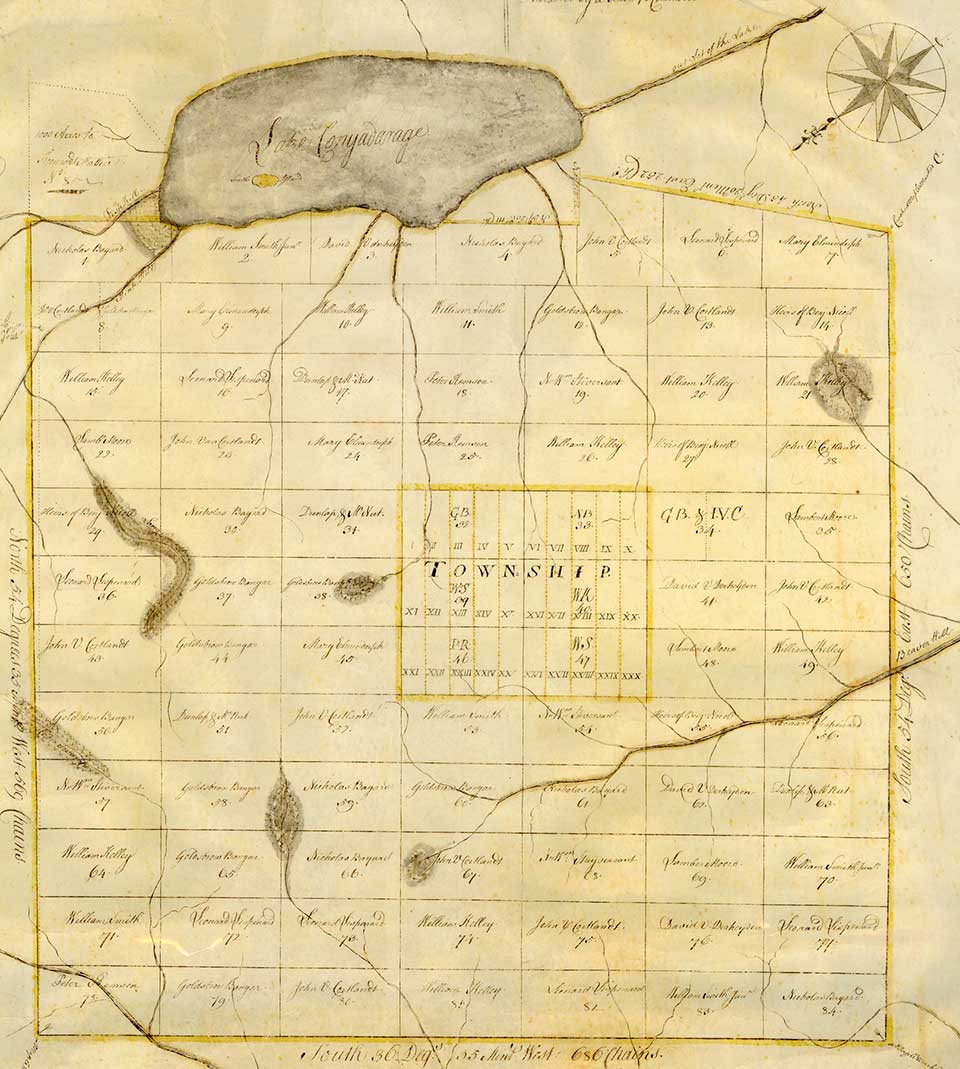
From A Map of a Tract of Land in the County of Albany on the West Side of Lake Canyadarage [Canadarago] Granted to David Schuyler & Others 3d June 1755.
"Laid out into 84 Lots Each Containing 539 acres, 6 of Which…are laid out into 107 Acre Lots in order for a Township." Ref
This early effort at urban planning declared a “township” at the center of the rectangular Schuyler Patent. No such "township" was ever built. Real towns grew up naturally, along rivers, the natural highways of the time.
The first Colburns bought land in the lower left corner of Schuyler Patent.
Edward and Esther built a homestead atop what is known locally as Plainfield Hill. At the first Plainfield Town Meeting, in 1799, Edward and Ellis Colburn were named “Overseers of Highways.” [At this meeting it was also agreed “that hogs run at large.”] Eventually, Ellis, David, Lewis and Jonathan all purchased property on the hill. It is hard to imagine why these brothers would select mountainside property to farm! It would seem that they soon came to their senses as they moved down the mountain and dispersed.Ref

The town of Plainfield, northwest corner of Otsego County, NY
An explanation for their choice can be found in an another excellent Alan Taylor portrait of frontier life, The Great Change Begins: Settling the Forest of Central New York: Ref
The longer-resident Dutch and German settlers of New York disdained the uplands and clung close to the rivers, farming the fertile alluvial flats. Subject to annual floods, the flats were rich in topsoil and annual plants but relatively free of large thick trees.... Unlike the old-stock Yorkers, the Yankee newcomers who flocked into upstate New York after the Revolution readily settled in the hills that resembled their New England homeland. Adept at conquering a heavily timbered land and reconciled to hilly terrain, the Yankee settlers preferred to avoid the bottomlands as unhealthy and too expensive (and too crowded with Dutch and Germans).

The original Ellis and Betsey Colburn 1799 cabin still appears in an atlas published in 1868 Ref
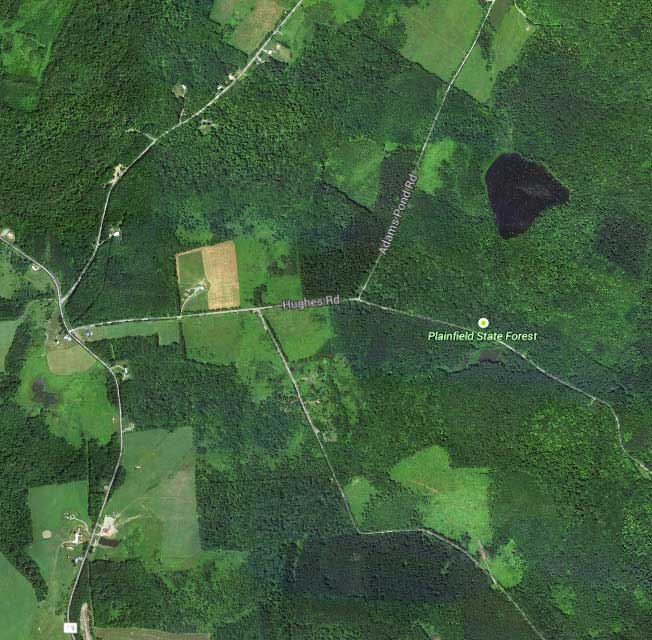
Google Maps image 2014. The layout of roads remains unchanged, but there are no longer houses in what is now Plainfield State Forest.
Not every Yankee farmer who bought land according to Cooper’s system managed to pay off his debt after ten years, but the brothers who remained in Otsego did. They probably prospered by ruthlessly burning the trees in their newly acquired forests to the ground, to produce the fertiizer potash. Export of potash to England was a lucrative business at the time. Ref By 1805 Ellis seems to have been sufficiently prosperous to purchase, for $1220, another 113 acres just north of his first property, in subdivision 76 of Schuyler’s patent (this may have been the transaction in which he bought out his twin brother Lewis, who moved west to Chatauqua County.) In 1809 he and Betsey sold the same parcel for $1500 (apparently making a tidy profit,) and for $690 bought a 91-acre parcel in the northern reaches of the town, in subdivision 67.
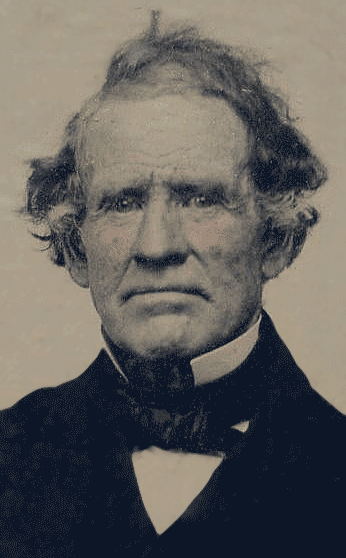
Ellis Colburn circa 1850.
And his wife Betsey to me known and by me examined separate and apart from her husband and she acknowledged that she executed the within deed of her own free art and did for the uses and purposes therein contained without fear or compulsion from her husband.
The brothers soon moved off the hill, though they likely kept both a town house and upland forests and farms. Edward moved northwest, to a small town on the Unadilla River. Ellis and David moved south, to Burlington. The other brothers moved on to land in far western New York, taken from the Iroquois in 1797 through another one-sided treaty.
The Ellis homestead cellar hole is quite visible in the fork between Hughes Road and Adams Pond Road. The Edward home site across Hughes Road is only marked by several piles of stones. As it was built to overhang the hill, there was no excavated cellar. It was still standing when my mother and dad visited circa 1926 and they recalled it having 3 living levels below the road level. Edward moved to a farm near Unadilla Forks in 1810 where he raised eight children.Not much of this conforms to recent experience. The hill is not at all steep enough to support multiple stories against it. Sometime in the 1980's, Eleanor Rider identified the spot on the map listed as "E. Colburn" as the site of the Ellis cabin. You have to look hard to make out the stones outlining where a cabin once stood.
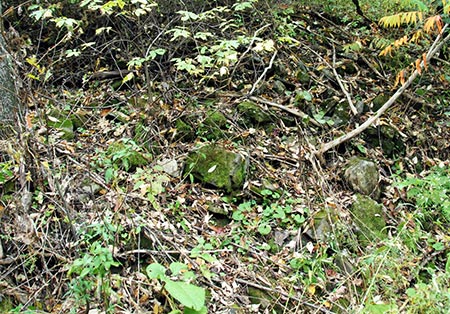
Cellar hole of the cabin Ellis and Betsey Colburn built in 1799. Now in Plainfield State Forest, Otsego County, New York
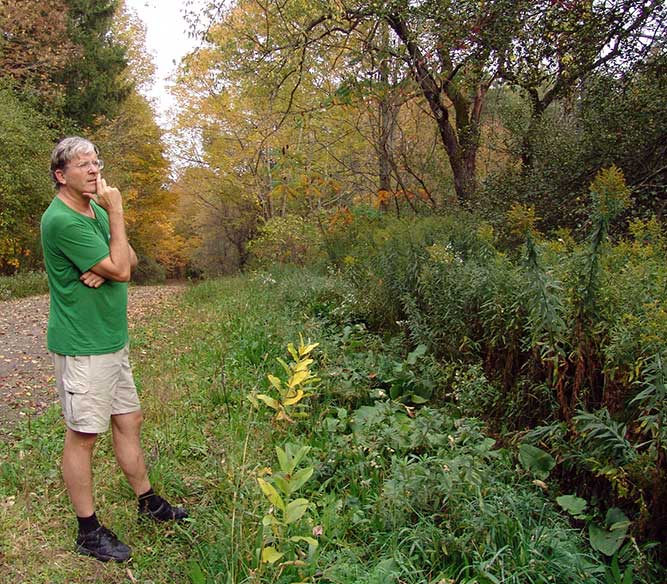
Bill Gasperini in 2008 contemplating huge, ancient apple trees at the site of the 1799 Colburn cabin, Plainfield State Forest NY
The cellar hole of [Ellis and Betsey’s] home on Plainfield Hill is still surrounded by an unusual type of rose, called locally New Hampshire roses, and supposedly brought from Rindge.The roses are small and pink. We picked some that May in the 80's, and laid them on Betsey Colburn's grave in the cemetery down the hill. Also still growing around the cellar hole are a lilac bush, like the ones memorialized in a classic editorial reprinted every year since 1929 in the Rutland, Vermont Herald, and gigantic ancient apple trees. These trees, the size of maples, are far larger than modern cultivated apples, which are grafted onto the branches of dwarf apple trees to facilitate harvesting.
Ellis Colburn Ambrotypes and Daguerreotypes
The eBay seller auctioned items from the estate of a Ralph Thompson, who lived in Tacoma, WA.
This listing consists of 2 daguerreotypes and 2 ambrotypes that were bundled together in an estate once belonging to Ralph & Grace Thompson of Tacoma. Ralph Thompson was a prominent attorney who began his practice by handling land & timber transactions for railroads & logging companies throughout the western half of Washington State, eventually serving as the head of the Pierce County Bar Association in 1937.
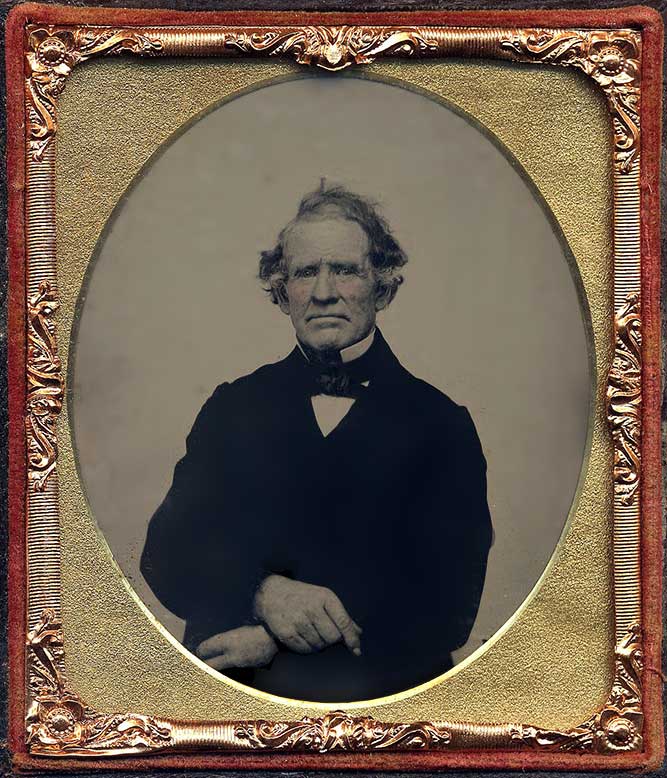
Ambrotype, Ellis Colburn circa 1850
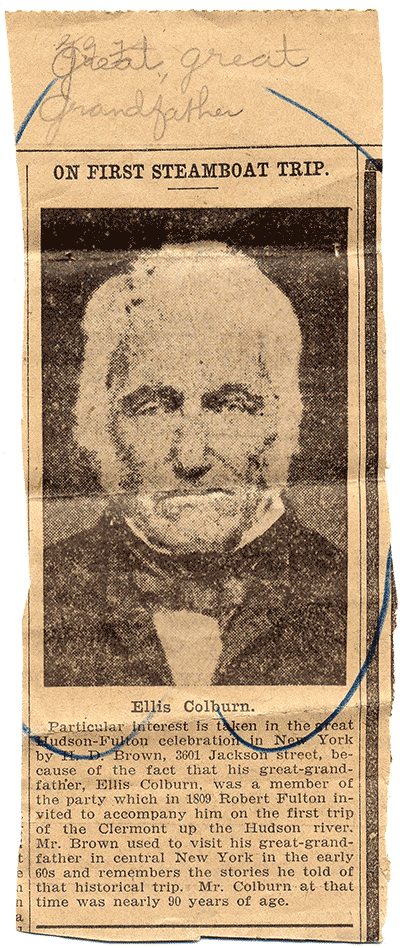
Newspaper clipping found in the ambrotype of Ellis Colburn
Particular interest is taken in the great Hudson-Fulton celebration in New York by H.D. Brown, 3601 Jackson Street, because of the fact that his great-grandfather, Ellis Colburn, was a member of the party which in 1809 Robert Fulton invited to accompany him on the first trip of the Clermont up the Hudson river. Mr. Brown used to visit his great-grandfather in central New York in the early 60s and remembers the stories he told of that historical trip. Mr. Colburn at that time was nearly 90 years of age.The eBay seller, interested in the history of these old images, did his homework:
The reporter was understandably confused because the centennial anniversary of Fulton’s first trip of the Clermont on the Hudson River was actually in 1907. 1909 was the 300th anniversary of the third and most famous of Henry (or Hendrick) Hudson’s four historic voyages; but because of the close proximity of the two anniversaries, their independent celebrations were merged in the creation of the Hudson-Fulton Celebration Commission in 1906, with the actual celebration taking place in 1909.
It is doubtful that an upstate farmer, still living on Plainfield Hill, could have managed to be among the elegant party of Livingstons and Schuylers that accompanied Fulton on his 1807 trip from New York to Albany. More likely Ellis rode Fulton's ship later on, when it made regular trips up and down the Hudson under the name North River Steamboat. Perhaps as he told and retold the story to ever-younger descendants it merged in his memory into participation in Fulton’s first trip.
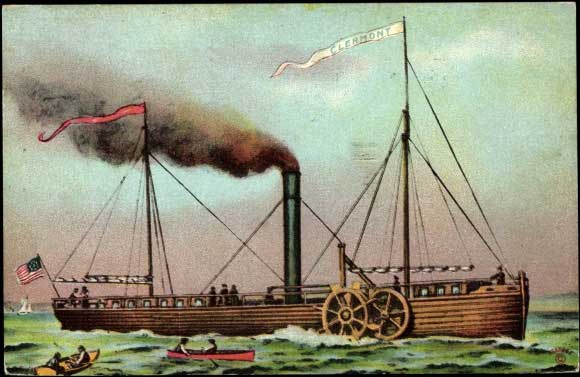
The Clermont, Robert Fulton's first steamship, which first chugged up the Hudson from New York to Albany in August 1807.
Grandfatherly exaggeration or not, if Ellis had not told the story it would not have been retold by a great-grandchild sixty years later to a reporter from an Iowa newspaper. There would have been no clipping saved with the old ambrotype by a cousin in Seattle. When this line of distant Colburn/Thompson cousins held an estate sale, these old 19th century ambrotypes would have joined the hundreds of thousands of beautiful 19th century portraits that have lost any connection with the descendants of those portrayed.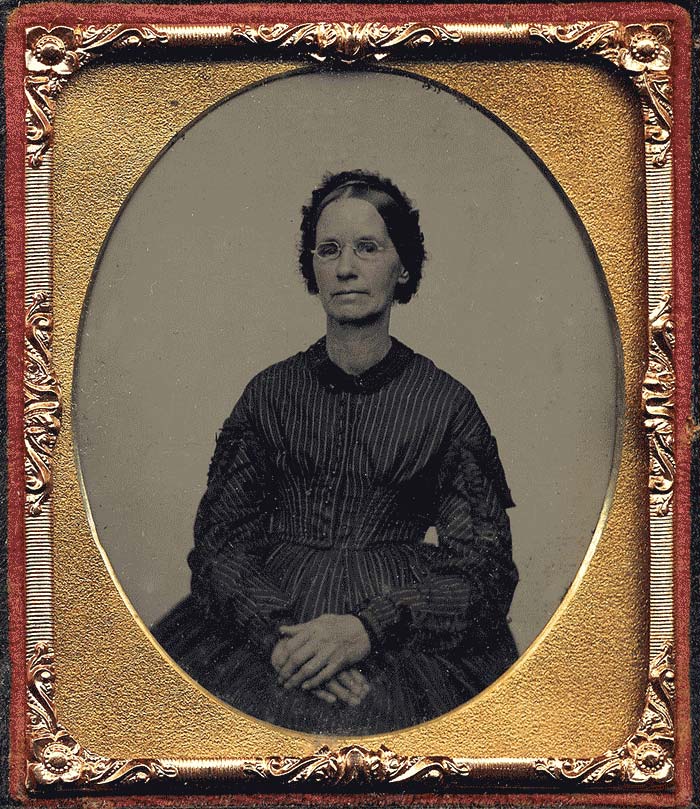
Ambrotype, probably Amanda Colburn Thompson
These images accompanied the Ellis Colburn ambrotype in the estate of Ralph Thompson of Tacoma, WA. Very likely they depict Ellis Colburn’s daughter Amanda and her husband, James Satterlee Thompson, with whom Ellis lived in his old age.
The Thompsons had four sons. In this generation, once again, one son remained in Otsego County, but the rest (Ellis, William and Elihu) emigrated to Montana. One of their descendants likely moved on to Tacoma, carrying the old images along, ultimately to be sold on eBay.
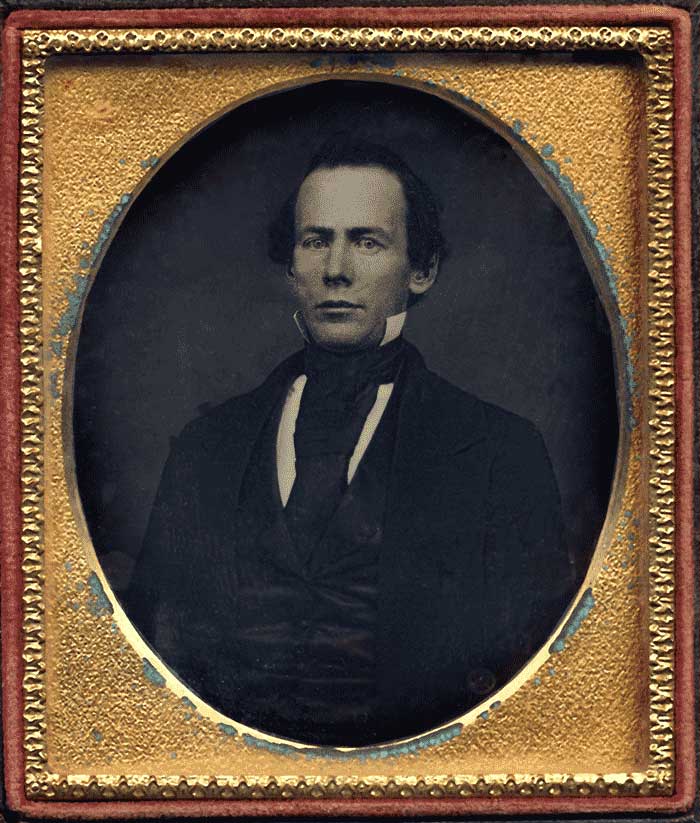
Daguerreotype, probably James Satterlee Thompson
The man pictured here appears younger than the woman identified as his wife Amanda. The technology used in his portrait (daguerreotype) preceded the technology used in her portrait (ambrotype.) His portrait was likely taken at least ten years before hers.
Ellis, Betsey and Family in the U.S. Census

1800 Census: Colburns appear on the lists for Plainfield, New York
In the second U.S. census, held in 1800, Ellis appears as a “free white male” in the 16 to 26 age bracket. A woman of similar age appears under Free White Females, undoubtedly his wife Betsey. They have one male and one female child under the age of 10 (Cynthia and George.)
Brothers Jonathan and Lewis also appear, though Edward does not (he may already have moved to Unadilla Flats.)
This form, used nationally, includes a category for slaves. No slaves were recorded as living in the upstate New York towns where the Colburns lived.

1810 Census: Ellis and Betsey are still counted in Plainfield
In 1810 Ellis and Betsey appear in the “26 to 45” slots for males and females respectively. George and Cynthia have moved up to “10 to 16.” Three more girls appear in the under-10 category (Nancy, Amanda and Lovina.) Lewis and Jonathan have moved further west to Chautaugua County (along with many Colburns of the next generation.)

1820 Census: Colburns are now registered in Burlington, New York
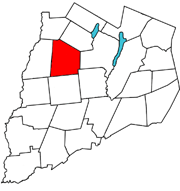
The town of Burlington, Otsego County

1830 Census: A new wife and an adopted son
Ellis' one son George had long been out on his own by this point. The male listed as part of the household in the 15-25 category could be the 23-year-old Nelson, son of brother Jonathan. After Jonathan died in 1814, apparently from disease contracted while fighting in the War of 1812, Nelson was adopted by his uncles Ellis and Edward.
Ellis and Betsey are memorialized in a cemetery apparently shared by different Baptist churches. They were members of (and helped found) the Free Will Baptist Church, which met in a building across the street from the First Baptist Church at least until 1867. Whatever differences kept the two congregations separate in life were apparently not enough to keep them from sharing a cemetery.
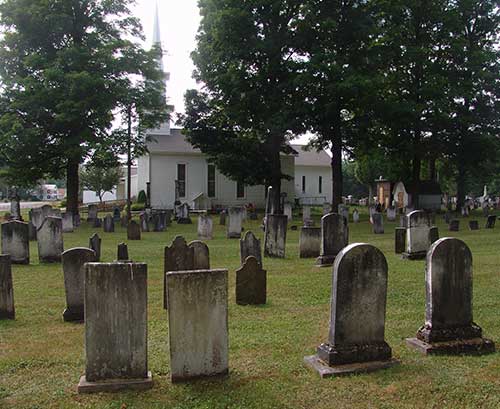
Colburn family graves in the cemetery next to the First Baptist Church in Burlington Flats, 2012.

1840 Census
In 1840 Ellis and a woman (perhaps Sarah) appear in the 60 to 70 categories. The male listed as living with them may still be adopted nephew Nelson, who later moved to Michigan.

1850 Census
The 1850 census lists all the members of the household by name. Eldest daughter Cynthia still lives with her parents, as well as two men who may be farm workers.

1860 Census: Living with daughter Amanda
By the time of the 1860 census, although the 86-year-old Ellis is still listed as head of household, he is now living with his daughter Amanda, her husband, James Thompson, and their two youngest children.
Second wives are often barely mentioned in the available records. Although Eleanor Rider’s genealogy states that his second wife survived him, Sarah is not listed as living with Ellis in 1860, and she is not mentioned in his will.
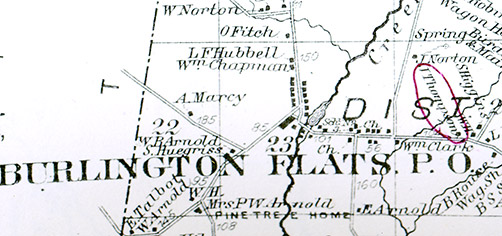
From the 1868 atlas of Otsego County. The cemetery is next to the “Ch” (church) listed just above the “S” of Burlington Flats. A short walk down the east-west road leads to the house of J(ames) Thompson.
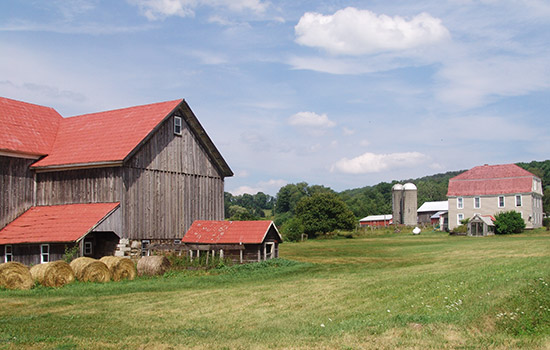
House and barn at the approximate spot where the James Thompson house stood in 1868. The modern house exterior may be built around an older structure.
ELLIS COLBURN
born March 17, 1774, Princeton MA
died April 8, 1864, Burlington Flats, NY
married 1 Betsey Pierce
Oct. 9, 1796 in Rindge by Rev. Seth Payson
born October 30, 1777 in Rindge
died July 27, 1823 Burlington Flats NY
children
Cynthia, b 1798 d 1865
George E. 1799-1870
m 1. Lois Mack 2. Sally Medbury
Nancy 1801-1850 m Flavel Day
Amanda 1804-1870 m James Thompson
Lovina 1807-1830 m Ephraim Chamberlain
Sophia 1810-1892 m Ephraim Chamberlain
Betsey 1812-1829
married 2 Sarah (?)
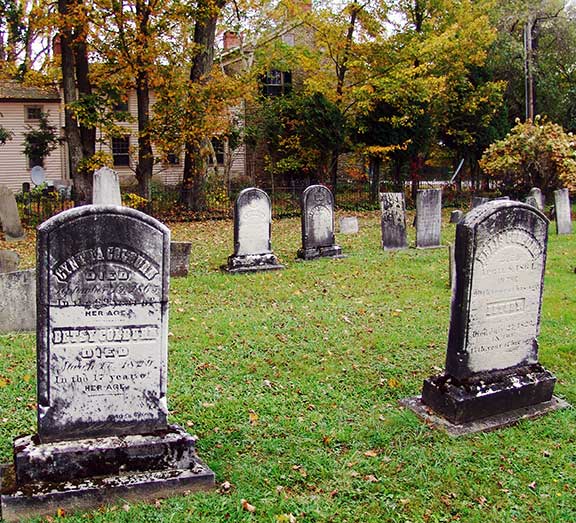
Burlington Flats Baptist Church cemetery October 2008
Foreground left: grave of unmarried daughters (eldest Cynthia, who survived them, and youngest Betsy, who died at age 17.)
Middleground: gravestones, in the same style as the foreground stones, of James and Amanda Thompson. To their right are the lower-quality gravestones of son George E. Colburn and his wife Lois.
Background: stone house built by Dr. Leonard Colburn, nephew of Ellis (son of Edward.)
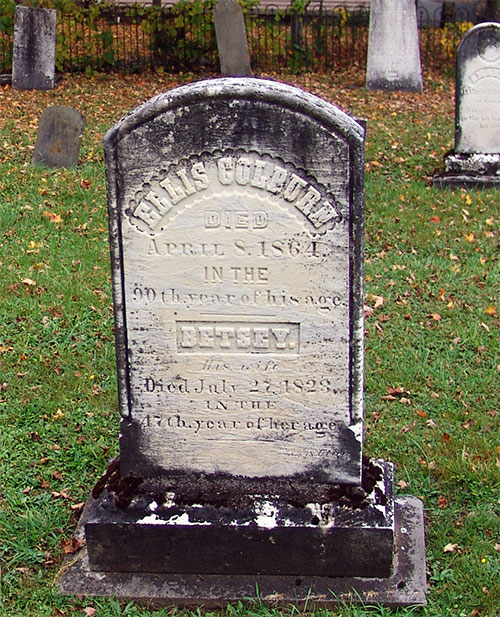
ELLIS COLBURN
Died
April 8, 1864
IN THE
90th years of his age
BETSEY
his wife
Died July 27, 1823
IN THE
47th year of her age
The proofs thereof to be sufficient, which said last will & testament and proofs are as follow, that is to say,
Will
In the name of God Amen. I Ellis Colburn of the town of Burlington in the County of Otsego and State of New York of the age of eighty three years and being of sound mind and memory so make publish and enclose this my last will and testament in manner following
That is to say,
First, I give & bequest unto George M. Colburn, Josiah Colburn, Elijah Colburn, Albert Colburn, Adam Colburn, Dela Colburn, Legrand Colburn & Melissa Colburn the Children of my son George Colburn each the sum of one hundred dollars.
Secondly, I give and devise unto my daughter Cynthia Colburn one equal undivided fourth part of all my real estate of whatsoever name or nature
and to my daughter Amanda Thompson one equal and undivided fourth part of all my real estate of whatsoever name or nature deducting from the value thereof four hundred dollars which I have given her husband James Thompson before the execution of this Will
and to my daughter Sophie Chamberlin the Wife of Ephraim Chamberlin I give and devise one equal undivided fourth part of all my real estate of whatsoever name or nature
and to Lucy Day, Jeb Day and Samuel Day the children of my daughter Nancy Day I give and devise one equal undivided fourth part of all my real estate whatsoever name or nature.
Thirdly I give & bequeath all the remainder of my personal estate goods and chattels of what nature or kind soever to my daughter Cynthia Colburn
and lastly I hereby appoint Ephraim Chamberlin of the town of Edmeston in the County of Otsego and State of New York and David Day of the town of Burlington County and State aforesaid Executors of this my last Will & Testament hereby revoking all former Wills by me made.
In witness whereof I have hereunto set my hand & seal this eighteenth day of August in the year of our Lord one thousand eight-hundred fifty-eight. -- -- Ellis Colburn
![]()
The above instrument consisting of one sheet was at the date thereof signed, sealed, published and declared by the said Ellis Colburn as and for his last Will & Testament in presence of us who at his request and in his presence and in the presence of each other have subscribed our names as witnesses thereof.
G.H Gorham Burlington Otsego County
D. A. Avory “ “ “ “ “ “
In the matter of foregoing The last Will and Testament Of Ellis Colburn, deceased Ref
Much as emigrant Nathaniel had done many generations before, though Ellis arrived in a new "wilderness" with very little, by the time he died he had amassed considerable property to give to each of his children. He made one curious exception, however, in his will. He gave 1/4 of his real estate to each of his surviving daughters, and $100 to each of the children of his only son George. George himself went unmentioned. The mystery of why he might have done this will be taken up in the next chapter.
